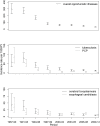Trends in AIDS-defining opportunistic illnesses incidence over 25 years in Rio de Janeiro, Brazil
- PMID: 24901419
- PMCID: PMC4047074
- DOI: 10.1371/journal.pone.0098666
Trends in AIDS-defining opportunistic illnesses incidence over 25 years in Rio de Janeiro, Brazil
Abstract
Objectives: To assess the temporal trends in incidence of AIDS-defining opportunistic illnesses in an urban cohort of a middle-income country.
Methods: HIV infected patients aged ≥ 18 years at cohort entry were included in this analysis. We calculated incidence rates per 1000 persons-years of observation for the first opportunistic illness presented after cohort enrollment, from 1987 to 2012. Trends for overall and specific opportunistic illnesses were tested and incidence rate ratios for the most recent calendar period were calculated as the ratio between the incidence rate observed in the most recent period of the study (2009-2012) and the incidence rate observed in first period of the study (1987-1990).
Results: Overall, 3378 patients were included in this analysis; of which 1119 (33%) patients presented an opportunistic illness during follow up. Incidence rates of all opportunistic illnesses decreased over time, and the overall opportunistic illness incidence rates fell from 295.4/1000 persons-years in 1987-1990 to 34.6/1000 persons-years in 2009-2012. Tuberculosis, esophageal candidiasis, cerebral toxoplasmosis and Pneumocystis jirovecii pneumonia were the most incident opportunistic illnesses in the cohort. Tuberculosis had the highest incidence rate in the study period. The peak in tuberculosis incidence occurred in 1991-1993 (80.8/1000 persons-years). Cerebral toxoplasmosis was the third most incident opportunistic illness in the study, with a peak of incidence of 43.6/1000 persons-year in 1987-1990.
Conclusions: All opportunistic illnesses incidence rates decreased over the years but they still occur in an unacceptable frequency. Tuberculosis co-infection among HIV-infected persists as an important challenge for health care professionals and policy makers in our setting. Impressively high rates of cerebral toxoplasmosis were found suggesting that its incidence among HIV-infected is linked to the high prevalence of Toxoplasma gondii infection in the general population.
Conflict of interest statement
Figures



Similar articles
-
Predictors of opportunistic illnesses incidence in post combination antiretroviral therapy era in an urban cohort from Rio de Janeiro, Brazil.BMC Infect Dis. 2016 Mar 22;16:134. doi: 10.1186/s12879-016-1462-x. BMC Infect Dis. 2016. PMID: 27001753 Free PMC article.
-
Surveillance for AIDS-defining opportunistic illnesses, 1992-1997.MMWR CDC Surveill Summ. 1999 Apr 16;48(2):1-22. MMWR CDC Surveill Summ. 1999. PMID: 12412613
-
Comparison of clinical response to initial highly active antiretroviral therapy in the patients in clinical care in the United States and Brazil.J Acquir Immune Defic Syndr. 2007 Aug 15;45(5):515-20. doi: 10.1097/QAI.0b013e3180decb6a. J Acquir Immune Defic Syndr. 2007. PMID: 17558332
-
[Highly Active AntiRetroviral Therapy and opportunistic protozoan infections].Parassitologia. 2004 Jun;46(1-2):89-93. Parassitologia. 2004. PMID: 15305694 Review. Italian.
-
Preventing opportunistic infections in human immunodeficiency virus-infected persons: implications for the developing world.Am J Trop Med Hyg. 1996 Jul;55(1):1-11. Am J Trop Med Hyg. 1996. PMID: 8702012 Review.
Cited by
-
HIV-associated opportunistic CNS infections: pathophysiology, diagnosis and treatment.Nat Rev Neurol. 2016 Oct 27;12(11):662-674. doi: 10.1038/nrneurol.2016.149. Nat Rev Neurol. 2016. PMID: 27786246 Review.
-
Hospitalization rates, length of stay and in-hospital mortality in a cohort of HIV infected patients from Rio de Janeiro, Brazil.Braz J Infect Dis. 2017 Mar-Apr;21(2):190-195. doi: 10.1016/j.bjid.2016.10.007. Epub 2016 Dec 3. Braz J Infect Dis. 2017. PMID: 27918889 Free PMC article.
-
HIV-Associated Cryptococcal Meningitis Patients Treated with Amphotericin B Deoxycholate Plus Flucytosine under Routine Care Conditions in a Referral Center in São Paulo, Brazil.Mycopathologia. 2021 Mar;186(1):93-102. doi: 10.1007/s11046-020-00512-2. Epub 2020 Nov 30. Mycopathologia. 2021. PMID: 33258083
-
Six-month survival of critically ill patients with HIV-related disease and tuberculosis: a retrospective study.BMC Infect Dis. 2016 Jun 10;16:270. doi: 10.1186/s12879-016-1644-6. BMC Infect Dis. 2016. PMID: 27286652 Free PMC article.
-
Early Antiretroviral Therapy in AIDS Patients Presenting With Toxoplasma gondii Encephalitis Is Associated With More Sequelae but Not Increased Mortality.Front Med (Lausanne). 2022 Feb 25;9:759091. doi: 10.3389/fmed.2022.759091. eCollection 2022. Front Med (Lausanne). 2022. PMID: 35280886 Free PMC article.
References
-
- Badri M, Maartens G, Bekker LG, Wood R (2005) The spectrum and prognosis of AIDS-defining illnesses in Cape Town. The Southern African Journal of HIV Medicine 6(2): 11–16.
-
- Badri M, Wilson D, Wood R (2002) Effect of highly active antiretroviral therapy on incidence of tuberculosis in South Africa: a cohort study. Lancet 359(9323): 2059–2064. - PubMed
-
- Brodt HR, Kamps BS, Gute P, Knupp B, Staszewski S, et al. (1997) Changing incidence of AIDS-defining illnesses in the era of antiretroviral combination therapy. Aids 11(14): 1731–1738. - PubMed
-
- Buchacz K, Baker RK, Moorman AC, Richardson JT, Wood KC, et al. (2008) Rates of hospitalizations and associated diagnoses in a large multisite cohort of HIV patients in the United States, 1994–2005. Aids 22(11): 1345–1354. - PubMed
Publication types
MeSH terms
LinkOut - more resources
Full Text Sources
Other Literature Sources
Medical

